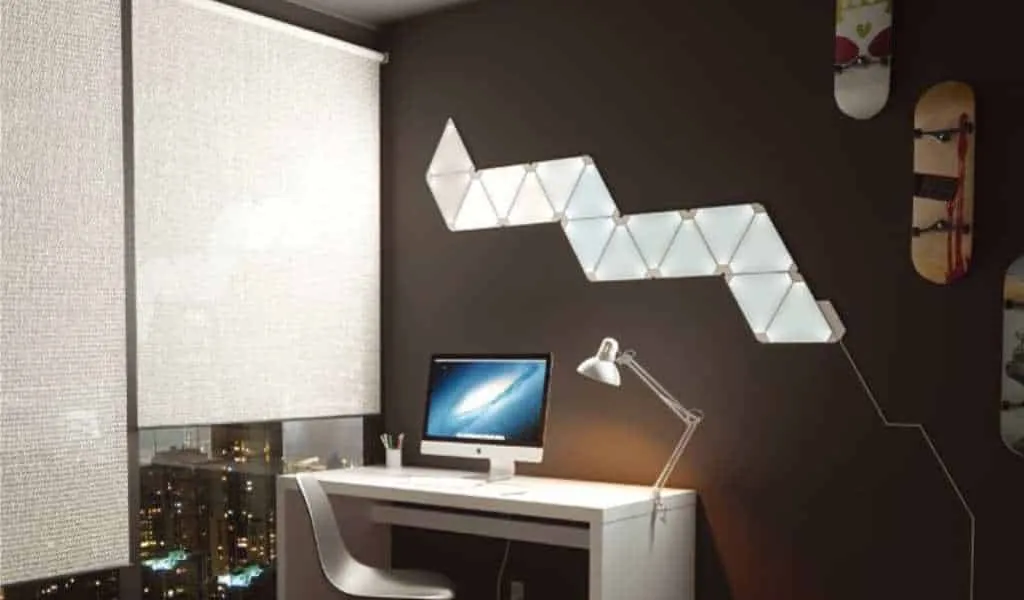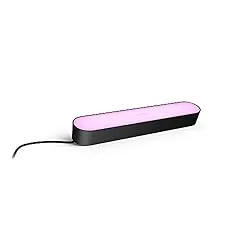Are Nanoleaf Light Panels Worth It? Should I Buy One?
Nanoleaf has become synonymous with smart LED light panels and is the only real contender. But they don’t come cheap, so are they worth it?
Yes, Nanoleaf panels are worth the extra cost if you’re serious about lighting. Not only are they extremely reliable, but the latest generation feature touch controls, can be synced to music or screens, and you can mix and match the lights.
Their feature set is well above any other smart panel currently available.
In the rest of this guide, I’ll cover the pros and cons of Nanoleaf as well as the commonly asked questions.
At the end, I have a couple of alternative recommendations if you’re still unsure.
Pros and Cons of Nanoleaf Panels
Here is my own verdict on the pros and cons of Nanoleaf light panels:
Immersive lighting experience
The biggest draw of these bulbs is the way they look and it’s something you really have to see with your own eyes in order to appreciate.
If you know a store that sells them, pop down and take a look as you’ll instantly fall for them.
The products use the full spectrum of 16 million colours, plus shades of white between 1200K-6500K, this means you can create any mood your heart desires.
Whether you’re looking for a more visual gaming experience, having friends over for a party or just want something casual for extra ambiance, you’ll find this with Nanoleaf.
Reliable
The Nanoleaf products are some of the most reliable on the market.
Granted, there may be some issues during set up (such as the Wi-Fi issue mentioned below), but once you have them up and running, they should work like clockwork.
The lights have a 25,000-hour life which would last 6 years even if left on for 12 hours a day.
Sync to your music or screens
With a built-in microphone, Nanoleaf light panels can sync to any music for a cool display, perfect if you’re having some friends over.
With the screen mirror feature your Nanoleaf panels can imitate the types of lighting on your screen.
This is accessed via their desktop app which explains why Nanoleaf is so popular with PC gamers.
Highly customisable
Nanoleaf products are highly customisable, they can fit together to form all sorts of interesting shapes and designs.
With the latest release, the Nanoleaf Shapes Triangles and Nanoleaf Shapes Hexagons can be used as part of the same light rig for even more customisation.
So, What About the Cons?
Expensive
The biggest set downside to the Nanoleaf lights is their price. No surprises here.
The initial investment will set you back in the region of £200 for a starter kit.
Luckily, once you have a starter kit which houses the controller and Wi-Fi unit, you can purchase expansion kits to extend your Nanoleaf lights.
Each controller can manage up to 30 light panels.
Only work on 2.4Ghz WiFi
This is a pretty standard issue for smart home devices, but I thought I’d throw it in for good measure.
They need to be connected to 2.4Ghz WiFi which can be a paid to set up if you have a dual band router that combines the two frequencies.
The answer is to separate the bands, check this article for more information.
Their product range is confusing
I don’t know about you, but I found their product line up quite confusing to understand.
There are three ranges; Nanoleaf Shape, Nanoleaf Canvas and Nanoleaf Light Panels (previously called Aurora).
You need to be clear which product you’re purchasing as this will determine the features, don’t rely on the shape of the lights as the same shapes exist within different products.
I’ve tried to explain the differences more clearly below.

How Big Are Nanoleaf Panels?
Nanoleaf panels are some of the biggest compared to other smart LED light panels.
Each panel is roughly 20 x 23cm (for the Nanoleaf Shape Hexagons) and you can connect up to 30 panels per power source.
How Long do Nanoleaf Panels Last?
Nanoleaf panels are made from LED bulbs which have a far higher life than standard incandescent bulbs.
Nanoleaf panels have a 25,000-hour life expectancy. This would last 3 years if on 24 hours a day or 6 years if on for 12 hours a day.
Can You Mix Nanoleaf Panels?
Yes, if you have Nanoleaf Shapes such as triangles, mini triangles or hexagonal shapes, then you can mix and match the panels.
If you have Nanoleaf Canvas (squares) or Nanoleaf Aurora, then unfortunately these cannot be mixed as they use different connectors, but you can still expand the lights using expansion packs with the same panels.
You can tell if you have the older triangles as they were not touch sensitive.
What’s the Difference Between Nanoleaf Shape, Panels and Canvas?
Nanoleaf hasn’t made it easy to distinguish between their products so I’ll try to break it down.
There are three types of product to choose from: Nanoleaf Shape, Nanoleaf Panels and Nanoleaf Canvas.
All of the Nanoleaf Products have these features:
- Sync to music
- Screen mirror to match a gaming monitor
- Connect up to 30 lights to one power supply
- Integrate with Alexa, Google Home and more
Then there are a few differences between the three as follows:
Nanoleaf Shape - Nanoleaf Shapes are available as Triangle, Mini-Triangle and Hexagonal shapes. The key difference between Nanoleaf Shape and other products is the ability to connect different shapes together. They also have touch control
Nanoleaf Panels - These are only available as triangles. They are more basic with no touch control and can only be used with other Nanoleaf Panels.
Nanoleaf Canvas – Nanoleaf Canvas are square in shape. They have a slightly different texture to the other products which is more quilted. Canvas also has touch control.
Are There Cheaper Alternatives to Nanoleaf?
I did write an article on the best Nanoleaf alternatives where I compared some of the cheaper options for those looking to light up their walls.
To be quite honest, they were nowhere near as good as the Nanoleaf product.
Many of the products I did not even include as they were too unreliable, and those that did were often a fraction of the size, so you’d need many more.
If you are interested in an alternative, I rate the Cololight LED panels as a good choice, they are less than half the price however they are also less than half the size.
Or, taking a different route, the Philips Hue Play Bar is an alternative way to light up your walls and has many similar features to the Nanoleaf such as syncing to your screen , plus they are also very reliable.
